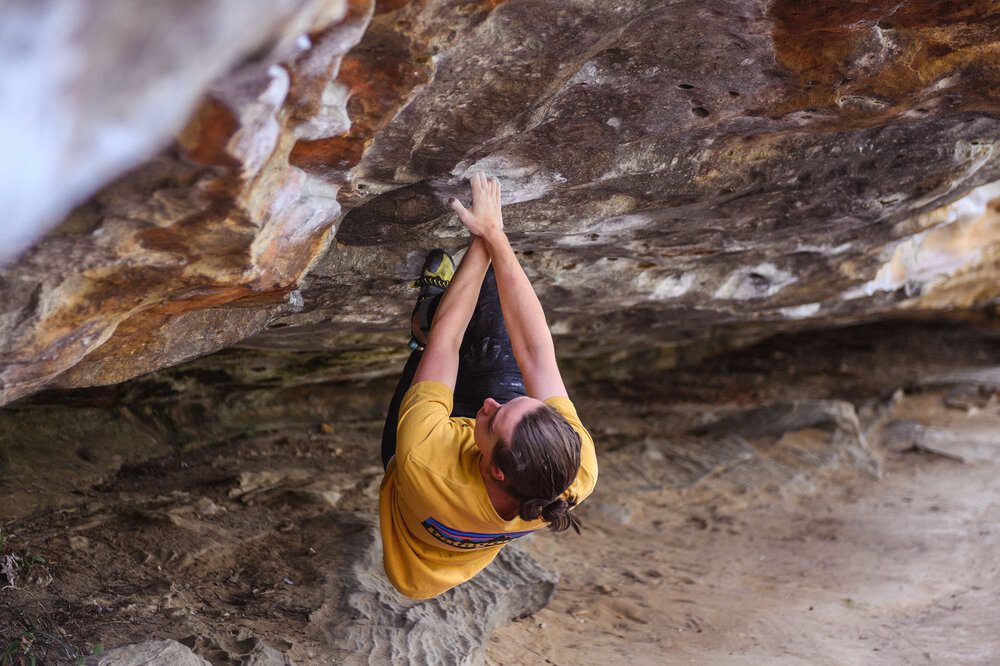
A couple of months of downtime could drive anyone a little bit mad, and there are only so many iso-projects that can be done to stave off the cabin fever. Fortunately, restrictions are beginning to ease, which means that we may be seeing your faces back at the gym sooner than later! Though what if you don’t want to wait? Well, welcome to the great outdoors.
Bouldering, specifically, has become a hugely popular form of rock climbing because of how accessible it is. Instead of needing ropes and hardware, the gear you need to get out and start climbing on some real rock is much simpler, and Sydney is famous for its bouldering!
If you’re new to the world of climbing on real rock, there’s a few considerations you need to take into account, as well as some ethics and principles to remember when you’re in the bush.
If you’ve never been climbing outdoors, it’s a good idea to go with a group of people that HAVE been outdoors. Nothing beats real-world experience and having someone experienced showing you how it all works can be infinitely valuable. Even one ‘grandmaster’ can teach a whole group of people that are new!
Before you head out, research where you’re going and the climbs you might try. Outdoor grades are usually stiffer than what you’ll find indoors, so prepare to be humbled - and keep it in your scope.
When you boulder in the gym, you can get away with having little more than your climbing shoes and some chalk - outdoors however, requires a few more essential items:
Climbing Shoes
Obviously. As you become a more experienced climber, you may choose to use different shoes for different kinds of climbs - indoor or out. You can read our in depth article on soft vs stiff climbing shoes along with some expert tips on fitting and, how to choose your next pair of climbing shoes.
Chalk
When you’re climbing routes, a small chalk bag that ties around your waist is definitely the way to go - however having a chalk bucket for your bouldering escapades is often more convenient as many models have pockets for all your accessories, and stand open on the ground so you can get both paws in. If you want to read more about chalk, check out my 2019 chalk review article here
Brushes
You can never have too many brushes! Used to clean dirt, tick marks and excess chalk from holds - stay away from harsh brushes, and consider a brush designed specifically for climbing. They’re usually made to be abused and some have some neat little features to go with them.
Bouldering Pad
Unlike in the gyms, you’re not surrounded by a huge sea of matting. Bouldering mats that you take outdoors are clever pieces of equipment that condense those mats into something you can carry in on your back. Made in all sorts of sizes with at least two different types of foam - the top layers spread the impact, and the bottom layers absorb it. Some are pretty basic, and others come with more nifty features.
First Aid Kit
This one’s non-negotiable! When you're outdoors, there’s the possibility of everything from cuts and grazes, to snake bites and accidents climbing. Get a first aid kit that’s appropriate to where you’ll be going and how far from help you’ll be, and most importantly, know how to use it.
Empty Plastic Bag
Why? Everything you take in, you have to take out. Rubbish wrappers, used tape, apple cores and banana skins - all of it. Even if there’s a bunch of trash left around that’s not yours - make it yours. It doesn’t take much to leave the areas we use better than how we found it.
Adequate Food and Water
There are no vending machines or coffee shops when you’re in the bush - make sure you’ve got enough fuel for your body, and plenty of water to go with it.
In addition to the above items, there are also some things you can take outdoor bouldering with you that aren’t essential but can still help:
Tools to warm up
In the gym, you have all the facilities to warm up properly, and easy climbs to ease yourself into the movement. Outdoors, you don’t always have that luxury. Some crags might lack the easier climbs to get moving, or space to really stretch out. Resistance bands are a good compact solution to help with a warm-up, otherwise, it’s not uncommon to warm up at home before heading out to a nearby crag!
Start Pad
A starter pad makes low ball problems with a sit start a little more comfortable, especially where a full-size pad is better used elsewhere. Some brands make them, or you could improvise with those craft skills you’ve been honing in isolation.
Crag Shoes
Choose your weapon - slides, thongs, runners, UGG boots… A comfortable pair of shoes to slip on when you’re not climbing can make your day!
Coffee
Personally, this one is absolutely an essential… If you really want to be the crowd favourite, brew a big pot of coffee and keep it in an insulated flask to share!
Safety Safety Safety
Safety is everything. Climbing is inherently dangerous, and when outdoors, that risk is increased. However, climbing outdoors can be as safe or as dangerous as you make it. In the world of outdoor bouldering, safety comes in the form of your pad and your spotters.
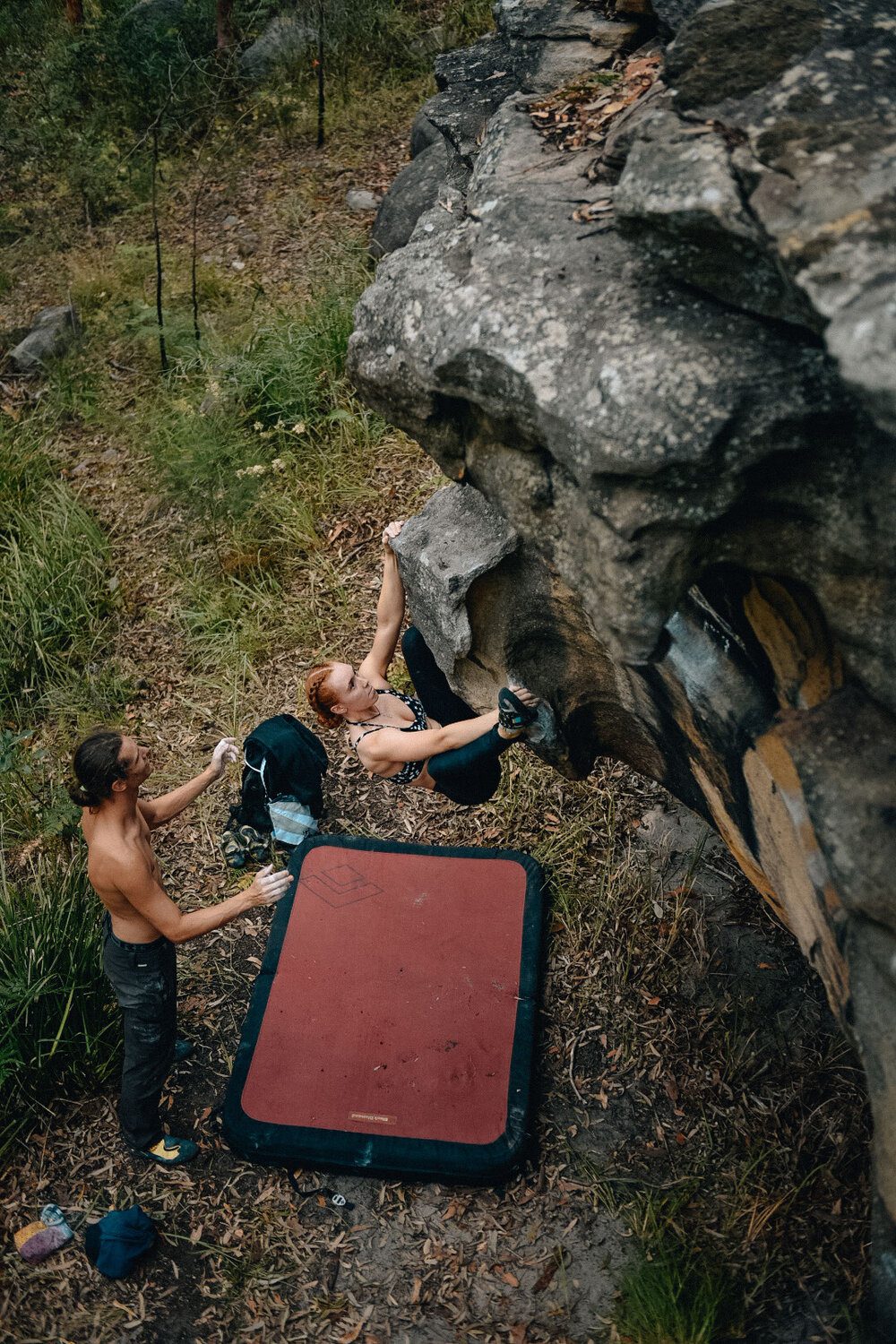
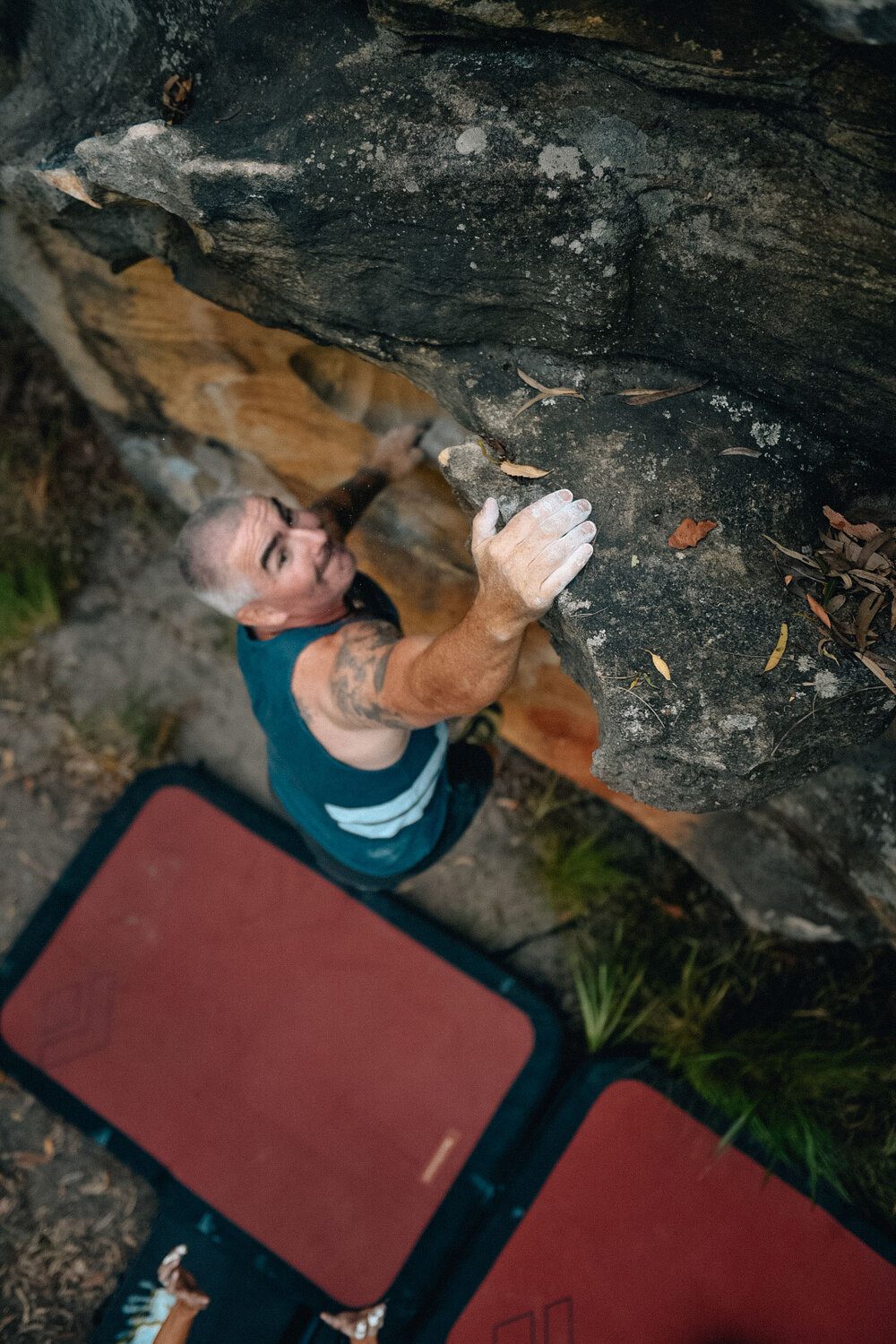
Putting your pad down on the ground is a lot more complex than… putting your pad on the ground. Before you slap it down, make sure the area is clear of sharp sticks and branches that could potentially compromise the pad. You also want to try and keep the pad as level as you can to avoid rolled ankles, so watch out for protrusions and uneven surfaces.
Pro Tip: Pads that are made with a hinge construction and not a ‘taco’ fold, can sometimes have rocks and other objects creep up into the hinge which is unprotected - be sure to watch out for that!
Where you put your pad down is pretty straight forward, especially if the climb is simple. Vertical climbs that go straight up can have a pad right under the climber, however, if the boulder problem starts to overhang or traverse, or if there are dynamic movements involved - think about where the landing zone for the climber will be and consider multiple pads (just be sure to fill the gaps between them).
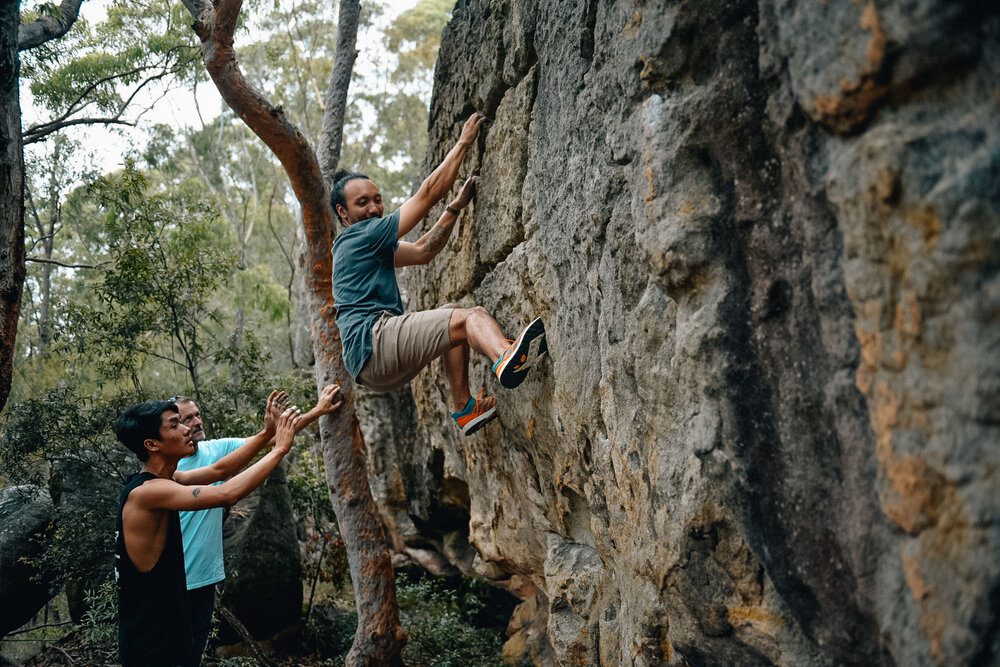
There is an art to good spotting, and experience is the best teacher - however, there are a few key points to keep in mind when spotting.
Firstly, your job as a spotter is not to catch the climber like superman. You are there to direct the climber onto the pad, letting the pad do the work. ‘Advanced’ spotting techniques on highball boulder problems may warrant a bit more of an active spot, but for the most part, you’re there to make sure they land where they’re meant to land.
On overhanging boulders, there is an added danger that the climber’s head may overshoot the pad, so be sure to take that into account when moving the pad and spotting. Injuries can occur even on low boulders.
When you’re spotting, keep your knees and elbows slightly bent to absorb some of the impact, and keep a stable stance so you yourself don’t get pushed off balance. Keep your hands high and stay alert, from the second the climber pulls on, all the way to them clearing the top out. They might seem like they’ve passed the crux when they’re topping out - but they’re also the highest up they’ll be.
When you’re spotting a falling climber, aim for their hips or waist. If you grab them too high you’ll end up just pushing them over and ramming their head into the wall… however, on overhangs and roofs, the shoulders are a good place to aim because it will tip the falling climber upright, back onto their feet.
The conversation about crag access and climber etiquette is a broad topic that will never end and could even be a whole separate discussion - however, the principles of climber etiquette is quite simple and hugely important given the current climate around social distancing regulations as restrictions begin to ease. So please, keep the following in mind:
Go to the bathroom before you leave!
Especially if you’re toting coffee along with you, try to do your doodoo before you get to the crag. If you can’t hold it, make sure you know the correct ways of burying or packing out your business. Around Sydney, many crags are close to bodies of water along rivers and estuaries, which mean your options of where you can bury your poop are even more limited.
Respect social distancing!
The restrictions of what we can and can’t do are quickly changing, so make sure you’re up to date and following the rules. If you get to the crag and there’s a bunch of cars already - consider moving somewhere else. Even if you’re at the crag and you notice it starting to get a bit busier - the rock isn’t going anywhere - move around, or move on.
Rubbish rubbish rubbish.
Just because your banana skin is somewhat biodegradable, don’t toss it in the bush. Everything - and I mean EVERYTHING - you take in, needs to be taken out. Whilst you’re there, pick up some rubbish that may have been left also. Not everyone who goes into the areas we climb may be there with the same intentions, and more often than not you’ll walk into a crag and find rubbish of sorts. It may not be yours, but it doesn’t take much to pick it up for the sake of all that choose to enjoy these areas.
Be conservative with your chalk.
Many people find chalk marks unsightly, so brush off what you’ve added before you leave, and keep the tick marks to an absolute minimum. It might be hard for an indoor climber to get used to searching for the holds without them - but that’s just part of the fun!
Respect the nature around you.
The Australian bush is hardy, but also sensitive. Stick to established tracks and trails, don’t light fires, and be aware of the ecosystem whose space you’re in. Watch where you step, and leave that big rock where it is. Do what you can to minimise the impact.
Think twice about music.
A few quiet psych tunes might be alright, but be aware of your surroundings. If there are other people - at least ask them first. If there’s houses or public areas nearby - forget it! Leave your expensive boombox at home and take in the sounds of the bush.
The outdoors is there for everyone to enjoy, and as climbers, it is our responsibility to keep the places we love open and accessible, and to keep the reputation of climbers held high in the eyes of the public so we can keep doing what we love!
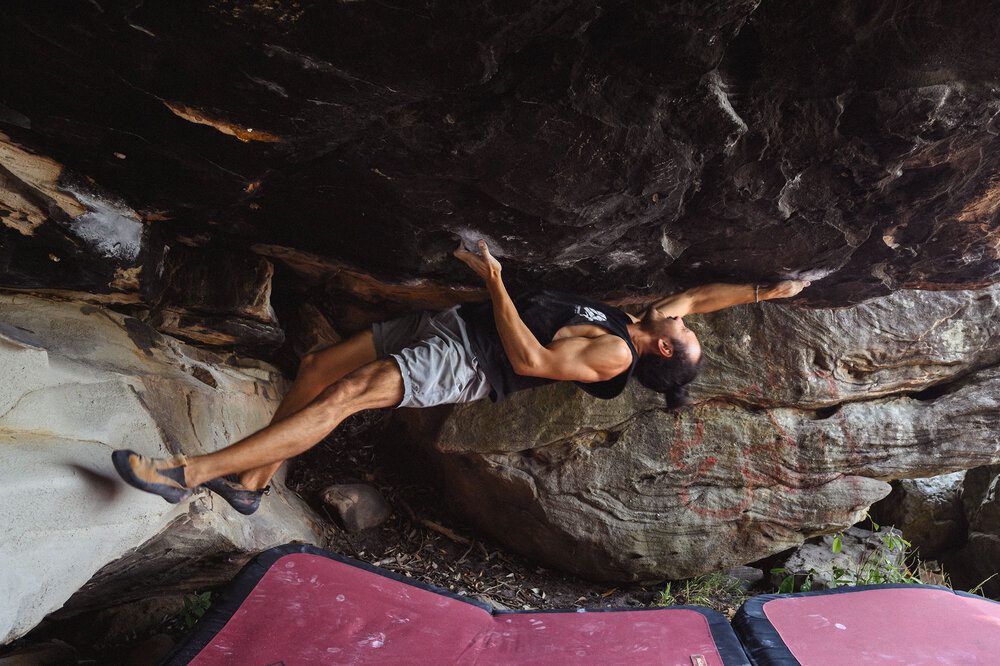
Adrian Mascenon
Whether on duty at Climb Fit Kirrawee in the dim hours of the morning, or staring down the newly set boulders with the locals in the evening - Adrian Mascenon is someone you’ll see at the gym often. With 13 years of climbing experience under his belt, 10 years of outdoor photography and adventure experience - he knows what’s up, and is more than happy to put pen to paper to make sure everyone can tap into what makes him tick.
Here ‘s a look at our fav bouldering goodies - available in our Climb Fit Pro Shop now.
A good looking brush to match your good looking self - with a skin board on the back to keep those calluses and tears at bay. Brush your holds, brush your hands!
1000D Cordura, a triple layer foam construction, and an included dual layer starter/gap pad - AND it looks this good? You'd think you're dreaming, but you'd be wrong.
120cm x 100cm of SoiLL sexyness.
Item is pick up only
PICK UP is FREE From Climb Fit Kirrawee or Climb Fit St Leonards. We will call you to arrange time and convenient location once order is made.
No brush, no crush. Make sure you can still crush with this.. brush.